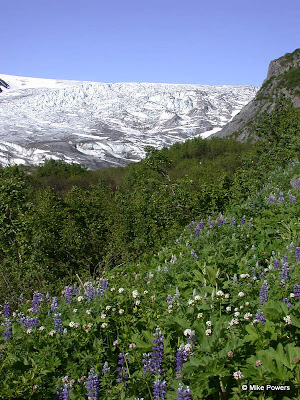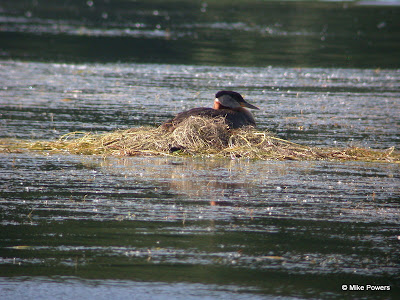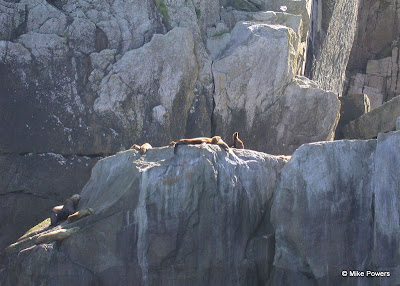As with any album of photos, memories reaching far beyond those images came flooding back. I recognized a thread running through those images, one that stretched from downtown Anchorage to the back-country wilderness. That thread starts and ends with Charles Darwin.
 Darwin's Theory, also a bar on G Street in Anchorage. The bar gained
Darwin's Theory, also a bar on G Street in Anchorage. The bar gainedwider notoriety when mentioned in "Cut it Out" (Indigo Girls).
One thought revolved around his writing. It's undeniably dense, as in Victorian-dense. Perhaps heretical to suggest, but I can't be alone in thinking he would have benefited from a copy of Strunk and White's "The Elements of Style." I know I shouldn't cast that stone, if you've visited this blog before you know I haven't cracked my copy in years. Further, Darwin was publishing On the Origin of Species (not the full title)* 100 years before E.B. White jumped in and popularized William Strunk's "forty-three page summation."
 A Hoary Marmot seems to survey the diversity covering
A Hoary Marmot seems to survey the diversity coveringthe Kenai Peninsula, which included us that morning.
But how many have actually read anything Charles Darwin wrote? It's tough going. I liken it to forcing one's way through a field overgrown with shrubs and vines - an entangled bank, to borrow an analogy. One Darwin scholar stated, "often you have to read a whole chapter to know what he is talking about." It's no wonder no one reads Darwin anymore, and that causes problems.
 A slime mold commonly known as "Dog Vomit," almost stepped on while
A slime mold commonly known as "Dog Vomit," almost stepped on whilehiking to Exit Glacier. Life comes in all shapes, sizes, forms, and textures.
First, Darwin is assigned quotes he never wrote. Many know the famous line,
“It is not the strongest of the species that survives, nor the most intelligent that survives. It is the one that is the most adaptable to change.”
The shortest of attention spans get through that one, and it nicely encapsulates a concept. The problem arises when we discover that it apparently does not appear in any of his writings. As this article suggests, people feel welcome to create such quotable lines because Darwin didn't write any.
 A Savannah Sparrow utilizes his favorite perch near his nest at
A Savannah Sparrow utilizes his favorite perch near his nest atCreamer's Field Migratory Waterfowl Refuge in Fairbanks.
The bigger problem: this "Darwinesque" quote doesn't capture what Darwin was trying to convey.
It is not the species that are most responsive to change that are likely to survive, (Cambridge professor John van Wyhe) explained. "It is the ones that are lucky, or already have the right features that can be passed on to the next generation."
Of course, having an audience not versed in Darwin makes it easier to build a straw man argument to knock down, inflaming public opinion. That frustrates me, but it's not where I want to go right now.
To understand the concepts, to appreciate the beauty, to fully grasp how painstakingly careful he was in observing the natural world, noting patterns, assembling ideas, and (finally) publishing, reading the source is so important. Yes, it's hard in the world we live in, the age of sound bytes, abridged books-on-tape, 30-minute sitcoms, and the mindless chatter that is talk radio, but it's worth it.
What you'll find in Darwin's writings is cutting edge. It's revolutionary, it's parsimonious, it's timeless. The idea is elegant, solid. It provides the intellectual framework that every branch of biology hangs from, and it gracefully supports them all. That's not to say Darwin's idea was finished. Much needed to be filled in light of new discoveries (like the entire field of genetics), there have been adjustments made to and arguments against the mechanisms he proposed, but it's not been replaced.
That is the way science works, and a Theory that endures 150 years (and counting) of rigorous testing is something, obviously, for the ages. 150 years later his Victorian prose remains invigorating, maybe not for the sentence structure, impressively long sentences, and liberal use of commas and semi-colons, but certainly for the ideas encapsulated within.
His fabled tangled bank sprawled out before us during a picturesque hike on our first Alaska morning. Thick vegetation impeded leaving the trail, but life was bursting all around us. Intertwined branches held leaves of various shapes, sizes, and shades of green. The songs of Wilson's and Orange-crowned Warblers, of White-crowned and Fox Sparrows, were heard, though the birds seldom seen. Insects of many forms were omnipresent, wildflowers of nearly every color carpeted the open areas.
 A view of the Exit Glacier, part of the Harding Ice Field,
A view of the Exit Glacier, part of the Harding Ice Field,surrounded by the beauty created by biological diversity
- the origin of which was proposed by Charles Darwin.
Cheesy as I am, I wanted to say something aloud, something deep and meaningful. I wanted to quote Darwin, but couldn't recall his words, only the concept. Now, on the 200th anniversary of his birth I will leave them here, as they elevate every simple natural observation to a level of grandeur.
It is interesting to contemplate a tangled bank, clothed with many plants of many kinds, with birds singing on the bushes, with various insects flitting about, and with worms crawling through the damp earth, and to reflect that these elaborately constructed forms, so different from each other, and dependent upon each other in so complex a manner, have all been produced by laws acting around us. . . . There is grandeur in this view of life, with its several powers, having been originally breathed by the Creator into a few forms or into one; and that, whilst this planet has gone cycling on according to the fixed law of gravity, from so simple a beginning endless forms most beautiful and most wonderful have been, and are being, evolved.
Thank you, and Happy Birthday, Mr. Darwin.
* Full title of Darwin's seminal work: On the Origin of Species by Means of Natural Selection, or The Preservation of Favoured Races in the Struggle for Life.
-







3 comments:
I agree that Darwin is difficult to read, definitely a product of his times.
We're lucky there are so many excellent nature writers around, though, that pick up the slack. I particularly like Jared Diamond and David Quammen. Really wonderful modern science writers that make the ideas come alive.
Nate - glad that you mentioned David Quammen, he's been one of my favorite nature writers since his days at Outside Magazine. "The Song of the Dodo" is one of the top books I recommend everyone read as he takes a difficult topic and makes it not only accessible, but engaging. Ditto on Diamond (though, admittedly, it took me a while to get through "Guns, Germs, and Steel," but that's my fault, not his).
Since, as you state, Darwin was a "product of his times," I wonder what would a Darwin blog look like? How would it read?
-Mike
Wow.. these are the amazing pics. I am glad to see these pics. Really great collection.
Post a Comment